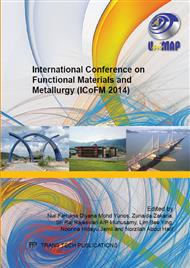[1]
J. Kemperl, J. Macek, Precipitation of Calcium Carbonate from Hydrated Lime of Variable Reactivity, Granulation and Optical Properties., Int. J. Miner. Process., 93 (2009), pp.84-88.
DOI: 10.1016/j.minpro.2009.05.006
Google Scholar
[2]
F.C. Meldrum, H. Colfen, Controlling Mineral Morphologies and Structures in Biological and Synthetic Systems., Chem. Rev., 108 (2008), pp.4332-4432.
DOI: 10.1021/cr8002856
Google Scholar
[3]
L. Xiang, Y. Xiang, Z.G. Wang, Y. Jin, Influence of Chemical Additives on the Formation of Super-Fine Calcium Carbonate., Powder Technology, 126 (2002), pp.129-133.
DOI: 10.1016/s0032-5910(02)00047-5
Google Scholar
[4]
Y.S. Han; G. Hadiko, M. Fuji, M. Takahashi, Effect of Flow Rate and CO2 Content on the Phase and Morphology of CaCO3 Prepared by Bubbling Method., Journal of Crystal Growth, 276 (2005), pp.541-548.
DOI: 10.1016/j.jcrysgro.2004.11.408
Google Scholar
[5]
W.M. Jung, S.H. Kang, W.S. Kim, C.K. Choi, Particle Morphology of Calcium Carbonate Precipitated by Gas-Liquid Reaction in a Couette-Taylor Reactor., Chemical Engineering Science., 55 (2000), pp.733-747.
DOI: 10.1016/s0009-2509(99)00395-4
Google Scholar
[6]
M. Matsumoto, T. Fukunaga, K. Onoe, Polymorph Control of Calcium Carbonate by Reactive Crystallization using Microbubble Technique., Chemical Engineering Research and Design, 88 (2010), pp.1624-1630.
DOI: 10.1016/j.cherd.2010.02.007
Google Scholar
[7]
S. Teir, S. Eloneva, R. Zevenhoven, Production of Precipitated Calcium Carbonate from Calcium Silicates and Carbon Dioxide, Energy Conversion and Management, 46 (2005), pp.2954-2979.
DOI: 10.1016/j.enconman.2005.02.009
Google Scholar
[8]
M.M.M.G.P.G. Mantilaka, D.G.G.P. Karunaratne, R.M.G. Rajapakse, H.M.T.G.A. Pitawala, Precipitated Calcium Carbonate/Poly(Methyl Methacrylate) Nanocomposite using Dolomite: Synthesis, Characterization and Properties., Powder Technology, 235 (2013).
DOI: 10.1016/j.powtec.2012.10.048
Google Scholar
[9]
H.A. Jakobsen, M. Mork, A. Grislingas, Stirred Tank Reactors.
Google Scholar
[10]
A.W. Nienow, On Impeller Circulation and Mixing Effectiveness in the Turbulent Flow Regime, Chemical Engineering Science, 52 (1997), pp.2557-2565.
DOI: 10.1016/s0009-2509(97)00072-9
Google Scholar
[11]
T. Kumaresan, J.B. Joshi, Effect of Impeller Design on the Flow Pattern and Mixing in Stirred Tanks, Chemical Engineering Journal, 115 (2006), pp.173-193.
DOI: 10.1016/j.cej.2005.10.002
Google Scholar
[12]
J. Aubin, C. Xuereb, Design of Multiple Impeller Stirred Tanks for the Mixing of Highly Viscous Fluids using CFD, Chemical Engineering Science, 61 (2006), pp.2913-2920.
DOI: 10.1016/j.ces.2005.10.075
Google Scholar
[13]
W.N. Al Nasser, A.H. Al Ruwaie, M.J. Hounslow, A.D. Salman, Influence of Electronic Antifouling on Agglomeration of Calcium Carbonate, Powder Technology, 206 (2011), pp.201-207.
DOI: 10.1016/j.powtec.2010.07.010
Google Scholar
[14]
H.V. Tran, L.D. Tran, H.D. Vu, H. Thai, Facile Surface Modification of Nanoprecipitated Calcium Carbonate by Adsorption of Sodium Stearate in Aqueous Solution., Colloids and Surfaces A: Physicochemical and Engineering Aspects, 366 (2010).
DOI: 10.1016/j.colsurfa.2010.05.029
Google Scholar
[15]
Helmut Colfen, Precipitation of Carbonates: Recent Progress in Controlled Production of Complex Shapes., Current Opinion in Colloid and Interface Science, 8 (2003), pp.23-31.
DOI: 10.1016/s1359-0294(03)00012-8
Google Scholar
[16]
R. Isopescu, C. Mateescu, M. Mihai, G. Dabija, The Effects of Organic Additives on Induction Time and Characteristics of Precipitated Calcium Carbonate, Chemical Engineering and Design, 88 (2010), pp.1450-1454.
DOI: 10.1016/j.cherd.2009.10.002
Google Scholar
[17]
J.G. Carmona, J.G. Morales, J.F. Sainz, R.R. Clemente, Morphological Characteristics and Aggregation of Calcite Crystal Obtained by Bubbling CO2 through a Ca(OH)2 Suspension in the Presence of Additives, Powder Technology, 130 (2003), pp.307-315.
DOI: 10.1016/s0032-5910(02)00209-7
Google Scholar
[18]
W.K. Park, S.J. Ko, S.W. Lee, K.H. Cho, J.W. Ahn, C. Han, Effects of Magnesium Chloride and Organic Additives on the Synthesis of Aragonite Precipitated Calcium Carbonate, Journal of Crystal Growth, 310 (2008), pp.2593-2601.
DOI: 10.1016/j.jcrysgro.2008.01.023
Google Scholar
[19]
H. Wei, Q. Shen, Y. Zhao, D.J. Wang, D.F. Xu, Influence of Polyvinylpyrrolidone on the Precipitation of Calcium Carbonate and on the Transformation of Vaterite to Calcite, Journal of Crystal Growth, 250 (2003), pp.516-524.
DOI: 10.1016/s0022-0248(02)02484-3
Google Scholar
[20]
S.Y. Park, W.S. Choi, Effects of Operating Factors on the Particle Size Dstribution and Particle Shape of Synthesized Precipitation CaCO3: Effect of Reaction Temperature, Blowing Rate of CO2 Gas and Initial Slurry Concentration of Ca(OH)2 on Reaction Completion Time., Advanced Powder Technology, 15 (2004).
DOI: 10.1163/15685520460740034
Google Scholar
[21]
J. Chen, L. Xiang, Controllable Synthesis of Calcium Carbonate Polymorphs at Different Temperatures., Powder Technology, 189 (2009), pp.64-69.
DOI: 10.1016/j.powtec.2008.06.004
Google Scholar
[22]
D. Carran, J. Hughes, A. Leslie, C. Kennedy, The Effect of Calcination Time upon the Slaking Properties of Quicklime, in Historic Mortars: Characterisation, Assessment and Repair. vol. 7, J. Valek et. al., ed RILEM Bookseries, (2012), pp.283-295.
DOI: 10.1007/978-94-007-4635-0_22
Google Scholar
[23]
H.G. Shin, H. Kim, Y. N. Kim, H.S. Lee, Effect of Reactivity of Quick Lime on the Properties of Hydrated Lime Sorbent for SO2 Removal., Journal Material Science Technology, 25 (2009), pp.229-332.
Google Scholar
[24]
J.R. Rosell, L. Haurie, A. Navarro, I.R. Cantalapiedra, Influence of the traditional slaking process on the lime putty characteristics, Construction and Building Materials, 55 (2014), pp.423-430.
DOI: 10.1016/j.conbuildmat.2014.01.007
Google Scholar
[25]
J. Lanas, J.I. Alvarez, Dolomitic Limes: Evolution of the Slaking Process under Different Conditions, Thermochimica Acta, 423 (2004), pp.1-12.
DOI: 10.1016/j.tca.2004.04.016
Google Scholar


